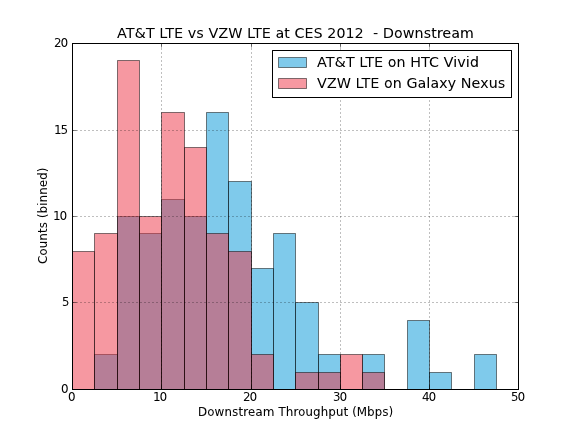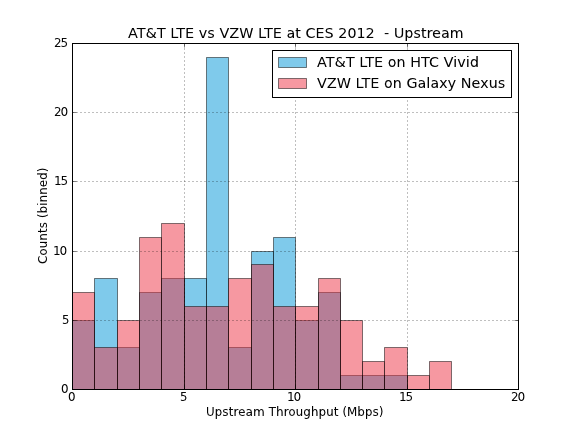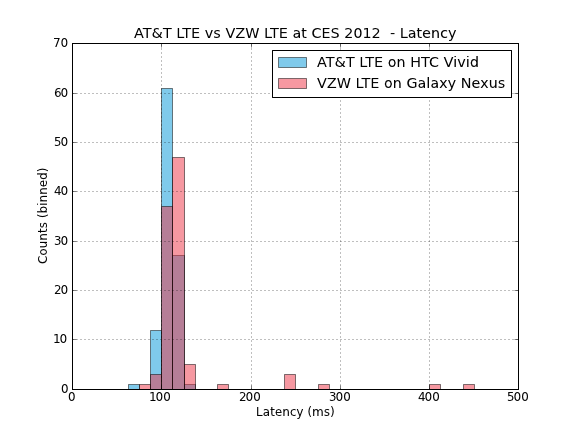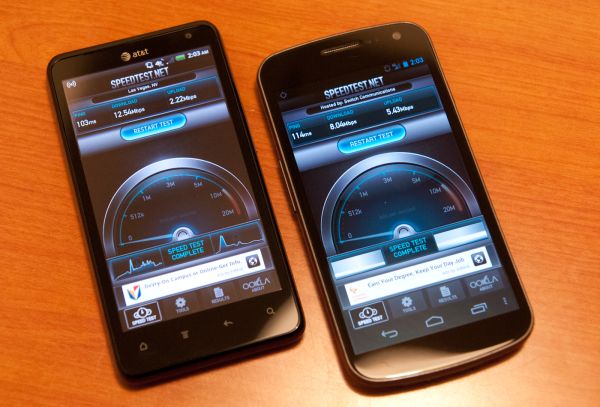CES 2012 LTE Face-Off - AT&T versus Verizon Wireless
by Brian Klug on January 13, 2012 5:18 AM ESTMy friends often think I've lost my mind given how many times I run speedtests on handsets in the process of reviewing them. The reason I'm compulsive about testing cellular network throughput and conditions is because it's massively important to the overall smartphone experience - remove the cellular connection, and you've got a very expensive personal media player at best. We've taken a good look at Verizon's 4G LTE a number of times, however we haven't yet given AT&T's LTE the same treatment, though it's coming soon.
We're wrapping up CES 2012 in Las Vegas, and the whole time I've been obsessively running throughput tests using Ookla's speedtest.net application on an HTC Vivid and CDMA/LTE Galaxy Nexus, two UE Category 3 devices on AT&T and Verizon Wireless LTE, respectively. I thought it worthwhile to share how AT&T LTE has stacked up next to Verizon Wireless 4G LTE during CES thus far. I've been running tests on both phones at the same time in both the Las Vegas Convention Center and Venetian CES venues in between meetings, as well as up and down the Strip during the convention. This isn't meant to be super scientific, but gives a decently fair gauge for how things have performed thus far.
The results are pretty interesting, and show that AT&T's LTE was slightly faster than Verizon 4G LTE during the show, though the two end up being pretty close at the end of the day. I've done the same statistical breakdown we do for smartphone reviews for the results, and made some color-coded histograms as well. I ended up running just north of 200 tests total, so ~100 per device.
Downstream Stats (Mbps)Avg: 17.681; Max: 45.708; Min: 3.78, StDev: 9.000Upstream Stats (Mbps)Avg: 6.575; Max: 14.188; Min: 0.105, StDev: 3.234Latency Stats (ms)Avg: 107.549; Max: 134; Min: 65, StDev: 8.999
Downstream Stats (Mbps)Avg: 11.185; Max: 33.571; Min: 0.184, StDev: 6.965Upstream Stats (Mbps)Avg: 7.133; Max: 16.44; Min: 0.135, StDev: 4.038Latency Stats (ms)Avg: 126.41; Max: 439; Min: 83, StDev: 51.554



The data ends up being pretty intriguing, and neither network honestly comes out dramatically ahead of the other. This isn't surprising considering both are running 10 MHz FDD-LTE on the 700 MHz band right now. AT&T also can deploy a 5 MHz FDD-LTE carrier on AWS in Las Vegas, though I'm not sure it is currently lit up, and I can't check if it's in use on the HTC Vivid like I can the Samsung Skyrocket. AT&T LTE posted better downstream numbers than VZW LTE overall and came in with a higher maximum throughput of just over 44 Mbps down, but is admittedly nowhere near as loaded with devices as Verizon's year-old 4G LTE network.
Subjectively, Verizon's 4G LTE coverage is also better than AT&T's in Las Vegas. I couldn't take down numbers on the handsets, but needless to say there were a number of areas where AT&T LTE didn't propagate where VZW LTE was perfectly fine. We got better 4G LTE signal in more casinos and hard-to-reach areas in the Venetian with Verizon than AT&T, though admittedly Verizon has been deploying and improving its network for much longer than AT&T.











24 Comments
View All Comments
name99 - Friday, January 13, 2012 - link
Hmm. Very interesting. That was a great explanation.It's sad when one hits these real world issues that limit exactly how well things can work (I'm reminded of the PAPR issue with OFDM) but you're obviously correct. Given the history and the current mix of random users of adjacent spectrum, I guess we're stuck for a while, until, presumably, horse trading slowly rationalizes things, one band, in one market, at a time.
SerafinaWeathers - Monday, February 8, 2016 - link
Thoughtful writing . I loved the details ! Does someone know where my business might get access to a template a form example to edit ?Brian Klug - Saturday, January 14, 2012 - link
Awesome write up and I completely agree with all of it - the carriers tell us some things, but are still very closed about talking much about the actual network. Getting metrics from Field Test on devices is just about as far as we are right now.I don't know if you saw it but we actually did take a decently in-depth look at LTE as a radio access technology and some of the bigger parts of eUTRAN when Verizon's deployment was just starting: http://www.anandtech.com/show/4289/verizon-4g-lte-...
The point of this little look under the pipeline banner is just to show what LTE looked like in Las Vegas during one of the world's largest trade shows with many other users onboard. Last year only the elite had 4G LTE dongles on VZW, this time I saw practically everyone carrying around either a VZW LTE handset or a VZW LTE datacard like I did (Pantech UML290 and the LG VL600 with MDM9600 and LG's L2000 basebands, respectively). I don't think I'd say either network was unloaded, though obviously AT&T has far fewer devices on it.
-Brian
mcnabney - Friday, January 13, 2012 - link
You are comparing a Verizon LTE network that has millions of phones actually running on it (since it has been up for more than a year) with a network that has hardly any devices sold. Other users restrict throughput, and I can't think of any gathering of existing Verizon LTE users that would be greater than CES. I'm sure that AT&T's HSPA network is also a bit bogged down in Las Vegas.phatboye - Friday, January 13, 2012 - link
If you read the article you will see that they already pointed that outirev210 - Friday, January 13, 2012 - link
I think this is a rather misleading article... interesting but misleading.A) AT&T's LTE network is not loaded and not fully built-out.
B) AT&T covers 1/3rd of the country with 10x10 @ 700, 1/3rd of the country with 5x5 @ 700, and the rest of the country is zero 700MHz.
Verizon has 22MHz of 700MHz spectrum nationwide and 44MHz in some urban markets.
The problem is, the wireless landscape is changing SO quickly, your results today will be 100% irrelevant by next CES.
Brian Klug - Friday, January 13, 2012 - link
This is all very true, however at least for the Las Vegas market, both AT&T and Verizon are running 10 MHz FDD (10x10).-Brian
umbrel - Friday, January 13, 2012 - link
There has been a lot of news about LTE lately, did it completely killed WiMax in the US? What about the rest of the world?ddrum2000 - Friday, January 13, 2012 - link
Mor or less. Sprint is moving away from WImax to LTE but this just began in the past month or so.jeffbui - Friday, January 13, 2012 - link
Were you able to use AT&T data throughout Vegas during CES? I can't even make phone calls there, let alone use data whenever there's an event there.